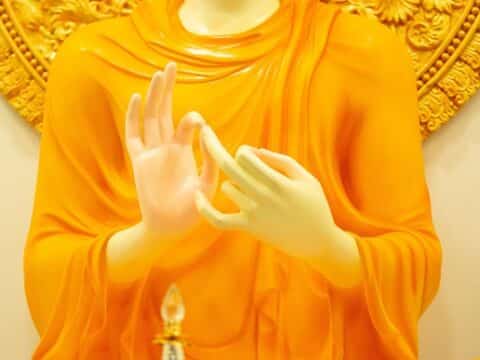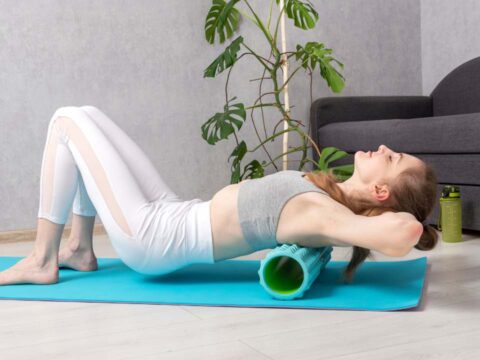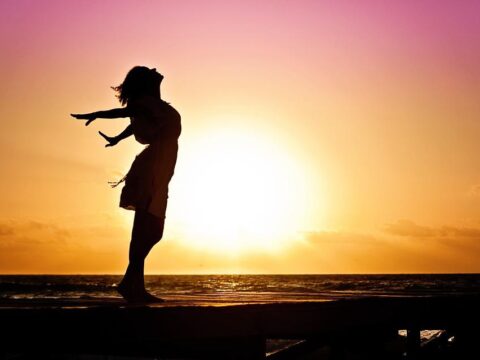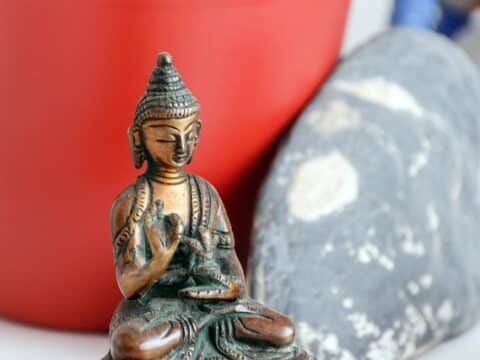Ready to find your zen and relax from the comfort of home? Yoga is a great way! To get started, try out some simple poses like forward bend or child’s pose. These postures are perfect for releasing tension in both mind and body – just make sure you have proper form if possible by consulting with an instructor. Give yourself at least 60 seconds on each so that you can truly feel connected within yourselves afterwards, it makes all the difference!
Podcast
6 Yoga Poses for relaxation
Relaxation with the Reclining Butterfly Pose (Supta Baddha Konasana)
For those looking to start their journey into meditation, the Reclining Butterfly Pose is a great way to begin! Not only does it stretch and open your hips, but with props this pose can be tailored for any level of experience. With its added benefits such as increased circulation and digestion aid, what more could you wish for?
To get the most out of this yoga pose, start by finding a comfortable cushion and propping a yoga block underneath your pelvic area. With feet together, let your knees relax downward for added depth in the stretch – supported from behind with that handy little extra assistance!
The lying bound angle pose can also help with digestive problems, infertility and sleep problems. It also improves blood flow to the pelvic area, which can help the ovaries, kidneys and prostate. It can also help with tension headaches and stress-related insomnia.
Supta Baddha Konaasana is a great meditative pose. It opens the chest and heart and improves flexibility of the entire leg. It can also help relieve PMS symptoms. If you are pregnant, practice this pose carefully with your teacher.
Lizard Pose (Utthan Pristhasana) for relaxation
Unlock your hips and stretch out like an open book with the lizard pose! This classic yoga asana is not for the faint of heart, requiring true dedication to achieve its full effects while also needing caution when practicing if you have limited flexibility. Feel yourself reach further into a healthier version of body and mindwhen taking on this unique challenge.
Utthan Pristhasana, the lizard pose, is a powerful hip opener that targets the buttocks and thigh muscles. It also strengthens the lower back and shoulders. This pose requires concentration and focus and is not recommended for yoga novices.
Lizard pose is often recommended for people with tight hips and is a great stretch for the hip flexors, hamstrings and quadriceps. It also increases flexibility of the hip ligaments and improves overall balance and flexibility.
It also reduces stress, stimulates creativity, helps relax and helps release emotions. It can also be beneficial for athletes as it helps activate the pelvis.
A good way to prepare for the more advanced hip openers is to practice this yoga pose in preparation for them. You should practice Utthan Pristhasana before attempting more advanced poses like Hanumanasana. However, it is not advisable for those who have recently undergone hip surgery or are currently nursing a hip injury.
Come to rest with the Sphinx Pose (Salamba Bhujangasana)
Sphinx Pose – its name inspired by the iconic figure of ancient Egypt – offers strength, balance and power. This time-honored yoga posture helps to stimulate internal organs while boosting lung capacity. It’s also a great way to get ready for deeper backbends! Hold it as long or short as you can. With your arms making a perfect right angle at your sides, take several breaths up to multiple minutes in this powerful pose.
This basic yoga pose stretches your entire back, neck, shoulders, arms and legs. It is a great way to strengthen your spine and relieve back pain.
It also helps you improve your posture and correct spinal misalignments. Be sure to practice with an experienced yoga instructor to ensure you get the most benefit from this pose.
It is an excellent variation of Cobra Pose and a wonderful way to improve your overall flexibility. First, lie on the floor with your stomach facing down. Then, stretch your legs out behind you.
Bend your elbows so that they are about shoulder width apart. If you can’t reach your elbows, use your fingertips to measure the distance.
To begin, take 4-6 breaths and gradually increase the number of breaths as you progress. The goal is to lengthen your spine and strengthen the muscles in your lower back and buttocks. To perform the Sphinx Pose correctly, you should have a stable spine and strong legs.
Relaxing the Nervous System with Legs on the Wall Pose (Viparita Karani)
Take your yoga practice to the wall with Viparita Karani, commonly known as the Legs on the Wall Pose. This inversion is an invigorating change of pace from traditional poses and has many benefits such as restoring blood circulation, providing relief for lower back pain and headaches, plus it helps soothe your frazzled nerves!
Legs on the wall is a restorative pose that allows the body to release tension and stress. It stretches the glutes, hamstrings, hip adductors and lower back. It is also helpful in relieving menstrual cramps and digestive problems.
While this yoga pose is commonly found in Iyengar yoga, it can be practiced in any style of yoga. It is usually practiced with the help of assistive devices such as a cushion, chair or block to provide additional support to the hips. Although it is considered safe for most people, it is important that you consult a physician before trying it.
Legs on the wall is a restorative pose that is good for people with high blood pressure. Inverting the legs helps the body regulate blood pressure and nourish the endocrine glands. It also improves blood circulation and helps the body balance metabolism.
Legs on the wall can be practiced for several minutes. During the exercise it is important to breathe naturally. Breathe deeply and evenly. You can also use an eye pillow to support the neck.
Resting with the Corpse Pose (Savasana)
Enjoy a moment of blissful relaxation with corpse pose – savasana. Lie flat on the floor with support beneath your lower back, and let yourself drift away as you take long breaths. Doing this simple yet effective resting pose will provide an unparalleled opportunity to unwind from life’s stresses and embrace tranquility.
This restful pose is most effective at the end of a yoga class. The deep relaxation and stillness will allow you to engage in more advanced activities.
Benefits of this pose include improved blood circulation, lower blood pressure, and help with anxiety and insomnia. It is also recommended for beginners who want to learn how to perform a deep, restorative yoga pose.
Corpse pose is a basic yoga pose. The goal is to relax your entire body, including your mind
This pose can last from two to twenty minutes. To exit this pose, raise your arms and legs and stretch your torso away from your head. Take a deep breath and exhale slowly.
Benefits of the Standing Forward Bend Pose (Uttanasana)
Strengthen and stretch the whole body with a few minutes of Uttanasana (Standing Forward Bend), an invigorating yoga pose! Not only does it help build up your hamstrings, glutes and calves, but its core strengthening properties in addition to improved digestion make it beneficial for overall health. Just three-to-five minutes every day will have you feeling relaxed, rejuvenated and stress relief guaranteed!
This standing forward bend is often used as a transitional pose between other yoga postures. This pose stretches the leg muscles, lower back and upper back. It also strengthens the lymphatic system. It is a good way to relieve headaches and stress. It also improves digestion and promotes a healthier immune system.
Standing forward bend stretches the hamstrings and calves and lengthens the spine. This pose also increases blood flow to the brain. It is a great way to feel good and focus the mind.
To perform this pose, stand with your feet hip-width apart and support yourself with your arms next to your feet. You can also hold on to your ankles or place your elbows behind your legs to keep your balance.
When doing the forward bend, you must be able to keep a straight back and maintain a firm position of the legs. To do this, tighten your thigh muscles and press down on the floor. You should also be able to rotate your shoulders and arms to the floor. Be sure to breathe in and out while holding the pose.

Other ways you can relax your mind at home
To bring peace and balance to your mind, learning how to relax is key. You can take calming activities like meditating or doing yoga into your own home – find a quiet place in the house, dimming the lights while turning off any electrical distractions such as TVs or radios.
Enhancing this tranquil atmosphere with essential oils that may help you ease into relaxation more naturally and quickly when you close your eyes logically follows!
For those who prefer assistance settling their minds during meditation time, guided sessions are available for extra clarity becoming beneficial for regulating high blood pressure levels along with other health issues.
Don’t forget about rewarding yourself afterwards too by resting at least ten minutes after it’s all said and done – an action which has been known to have positive effects on both body & spirit!



